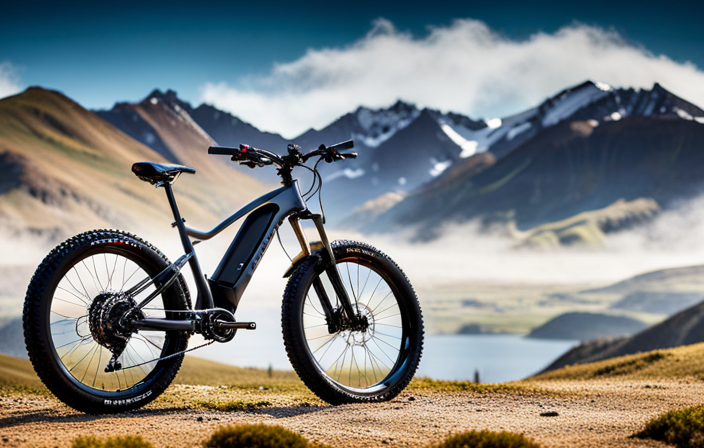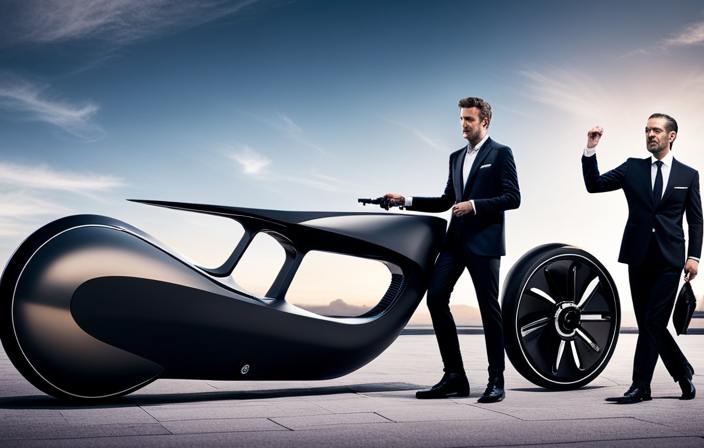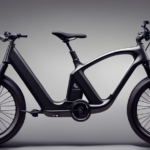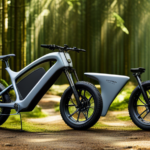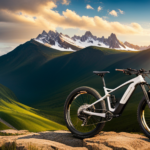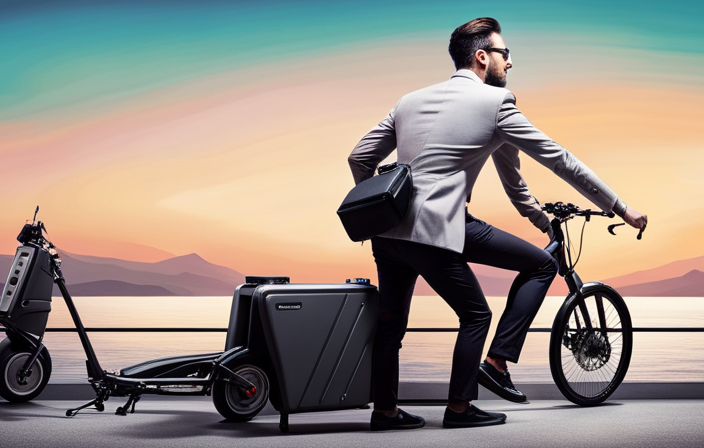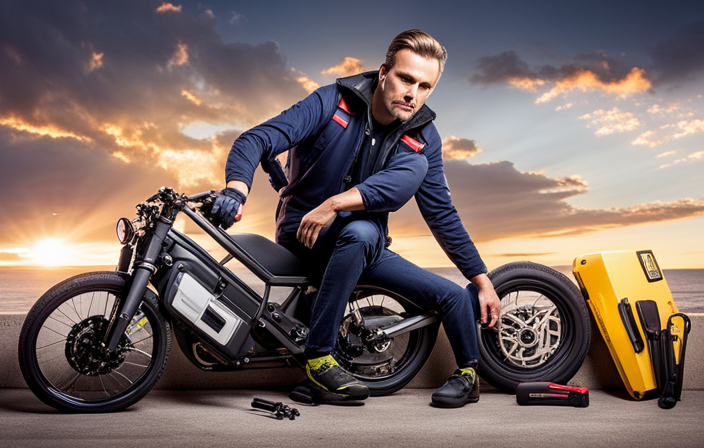Are you ready to take your mountain biking adventures to new heights? Look no further than the electric mountain bike.
With its powerful motor, long-lasting battery, and cutting-edge design, it’s the ultimate game-changer in the world of off-road cycling.
But with so many options on the market, how do you choose the perfect e-bike for your needs? Fear not, fellow riders, for I am here to guide you through the exhilarating journey of finding the ideal electric mountain bike that will elevate your riding experience to unprecedented levels.
Key Takeaways
- Consider your terrain and riding preferences when selecting tires, choosing between tubeless tires for better performance or tube tires for affordability.
- Evaluate weight distribution and its impact on stability and maneuverability, deciding between centralized weight distribution for rough terrains or rear-heavy weight distribution for climbs and technical trails.
- Determine the appropriate suspension type based on comfort preferences and terrain, choosing between a hardtail bike with a front suspension fork or a full suspension bike with front and rear suspension.
- Research brand reputation to gain insight into quality and satisfaction, considering the reputation of the company and its impact on reliability and performance.
Determining Your Riding Style and Needs
When choosing an electric mountain bike, it’s important to determine your riding style and needs. This not only ensures a more enjoyable riding experience, but also helps in selecting the right bike that suits your preferences.
One aspect to consider is bike maintenance. Electric mountain bikes require regular maintenance to keep them in optimal condition. It’s essential to have a basic understanding of how to maintain your bike, such as cleaning, lubricating the chain, and inspecting the brakes.
Another factor to take into account is choosing the right gear. Electric mountain bikes offer a wide range of gears to accommodate different terrains and riding styles. Understanding your riding style and the type of terrain you’ll be tackling will help you select the appropriate gear ratios for a smoother and more efficient ride.
By considering these factors, you’ll be able to choose an electric mountain bike that perfectly suits your needs and ensures an enjoyable riding experience.
Understanding Motor Power and Performance
To get the most out of your ride, it’s important to understand the power and performance of the motor. When choosing an electric mountain bike, you need to consider its motor efficiency and torque control.
Motor efficiency refers to how effectively the motor converts electrical energy into mechanical energy, resulting in a longer battery life and better overall performance. Look for a bike with a high motor efficiency rating to ensure you can ride longer without worrying about running out of power.
Torque control is another crucial factor to consider. It determines how much power the motor can deliver to the wheels, affecting your ability to climb steep hills and navigate challenging terrains. A bike with excellent torque control will provide you with the necessary power and control to conquer any trail with ease.
So, when choosing an electric mountain bike, pay close attention to motor efficiency and torque control for an exceptional riding experience.
Evaluating Battery Capacity and Range
Understanding the battery capacity and range is essential for evaluating the performance of an e-bike. The battery capacity determines how much power the bike can provide, while the range indicates how far you can ride before needing to recharge.
When evaluating battery life, there are a few key factors to consider:
- Battery Type: Different types of batteries, such as lithium-ion or nickel-metal hydride, offer varying levels of capacity and performance.
- Voltage: Higher voltage batteries generally provide more power and longer range.
- Amp-Hour Rating: This indicates the amount of energy the battery can store, with higher ratings offering longer rides.
- Terrain and Riding Style: Remember to consider how the battery will perform on different terrains and in different riding conditions.
Comparing range options is also crucial. Look for e-bikes with adjustable power modes, as this can extend the battery life depending on your needs. Additionally, consider the availability of charging stations and spare batteries, especially if you plan on taking longer rides.
Evaluating battery capacity and range ensures you choose an electric mountain bike that meets your riding needs and enhances your overall experience.
Considering Frame Design and Materials
Consider the frame design and materials to ensure it suits your preferences and enhances your riding experience. When choosing an electric mountain bike, two important factors to consider are the frame material and design. The most common frame materials for electric mountain bikes are aluminum and carbon. Aluminum frames are known for their durability and affordability, while carbon frames are lighter and offer better shock absorption.
In terms of frame design, you have the option of choosing between a hardtail and a full suspension. A hardtail bike has a suspension fork at the front but no rear suspension, making it lighter and more efficient for climbing. On the other hand, a full suspension bike has both front and rear suspension, providing better traction and comfort on rough terrains.
To help you make an informed decision, here’s a table comparing the key features of aluminum and carbon frames, as well as the differences between hardtail and full suspension bikes:
| Frame Material | Aluminum | Carbon |
|---|---|---|
| Weight | Heavier | Lighter |
| Durability | High | Medium |
| Cost | Affordable | Expensive |
| Frame Design | Hardtail | Full Suspension |
|---|---|---|
| Climbing Efficiency | High | Medium |
| Comfort on Rough Terrains | Medium | High |
Considering these factors will ensure that you choose an electric mountain bike with the right frame design and materials that suit your riding style and preferences.
Exploring Suspension Systems
Exploring suspension systems can greatly impact your riding experience. Having the right suspension system on your electric mountain bike is crucial for a smooth and enjoyable ride. There are different types of suspension systems available, each with their own pros and cons.
-
Full Suspension: This system has both front and rear shocks, providing maximum comfort and control on rough terrain. It absorbs bumps and impacts, allowing for better traction and handling. However, it can add weight to the bike and may require more maintenance.
-
Hardtail: A hardtail bike has a front suspension fork but no rear suspension. It offers a more efficient pedaling experience and is lighter than full suspension bikes. However, it may not provide as much comfort and control on rough trails.
-
Rigid: A rigid bike has no suspension at all. It is lightweight and low maintenance but offers minimal comfort and control on rough terrain.
-
Air Suspension: This system uses compressed air to adjust the suspension based on rider preference and trail conditions. It is lightweight and offers better tunability but can be more expensive.
-
Coil Suspension: This system uses metal coils to provide suspension. It is durable and offers a smooth ride but can add weight and may require more maintenance.
Choosing the right suspension system for your electric mountain bike depends on your riding style, terrain, and personal preferences. It’s important to test ride different bikes and consult with experts to find the perfect match for you.
Assessing Braking Systems and Components
To ensure your safety while riding, it’s important to assess the braking systems and components on your bike. When it comes to electric mountain bikes, durability and reliability are crucial factors to consider. You need a braking system that can withstand the demands of off-road riding and provide consistent performance.
There are different braking technologies available, and it’s essential to compare them to find the best fit for your needs. One common option is hydraulic disc brakes, which offer excellent stopping power and modulation. They are known for their durability and reliability, making them a popular choice among mountain bikers.
On the other hand, mechanical disc brakes are more affordable and easier to maintain, but they may not offer the same level of performance.
When assessing the braking systems and components, pay attention to factors such as the size of the rotors, the quality of the brake pads, and the overall build quality. Investing in reliable and durable braking systems will give you the confidence to tackle challenging terrains without compromising your safety.
Examining Wheel Size and Tires
Examining the wheel size and tires is essential for ensuring optimal performance and handling on off-road terrain. When it comes to electric mountain bikes, the choice between tubeless and tube tires can greatly impact your riding experience. Tubeless tires offer several advantages, including reduced rolling resistance, lower risk of punctures, and the ability to run lower tire pressures for improved traction. On the other hand, tube tires are more affordable and easier to maintain. It ultimately comes down to personal preference and the type of terrain you plan on riding.
Choosing the right tire tread is another crucial factor to consider. Different tread patterns are designed for specific conditions. For loose and muddy terrain, aggressive knobs and deep tread patterns provide superior grip. On hard-packed trails, a smoother and shallow tread pattern will offer lower rolling resistance and increased speed. It’s important to evaluate the terrain you’ll be riding on most frequently and select a tire tread that matches those conditions. By carefully considering wheel size, tire type, and tread pattern, you can ensure that your electric mountain bike performs at its best, allowing you to tackle any trail with confidence.
| Tubeless Tires | Tube Tires |
|---|---|
| Reduced rolling resistance | More affordable |
| Lower risk of punctures | Easier to maintain |
| Ability to run lower tire pressures | |
| Improved traction |
Looking at Weight and Maneuverability
Considering weight and maneuverability is crucial when looking for the right bike for you. These factors can greatly impact your riding experience, making it important to find a balance that suits your needs.
When it comes to weight distribution, electric mountain bikes vary in their design. Some models have a more centralized weight distribution, which can provide better stability and control on rough terrains. On the other hand, bikes with rear-mounted batteries and motors may have a rear-heavy weight distribution, making them more maneuverable and agile on climbs and technical trails.
Another important aspect to consider is the type of suspension the bike offers. Electric mountain bikes usually come with either a hardtail or full suspension setup. Hardtail bikes have a front suspension fork, while full suspension bikes have both front and rear suspension. Full suspension bikes are generally heavier due to the additional components, but they offer improved comfort and traction on rough terrain.
In conclusion, when choosing an electric mountain bike, carefully consider weight distribution and suspension types. Finding the right balance between weight and maneuverability will ensure you have a bike that suits your riding style and allows you to confidently tackle any trail.
Researching Brand Reputation and Customer Reviews
Researching brand reputation and customer reviews can provide valuable insight into the quality and satisfaction of a particular bike model. When it comes to choosing an electric mountain bike, knowing what other customers have experienced can make a big difference.
By reading brand reputation and customer reviews, you can gain a better understanding of the reliability and performance of different bike models. Brand reputation is important because it reflects the overall trustworthiness and consistency of a company’s products.
Positive customer reviews can give you confidence in your decision, as they highlight the positive experiences of others who have already purchased and used the bike. On the other hand, negative reviews can alert you to potential issues or shortcomings that you may want to consider before making your final choice.
So, take the time to research brand reputation and customer reviews to ensure you make an informed decision and find the electric mountain bike that best suits your needs.
Setting a Budget and Comparing Prices
To make the best decision for your needs, start by setting a budget and comparing prices for different models of electric mountain bikes.
When comparing features, keep in mind the specific requirements you have for your riding style. Look for features such as suspension, motor power, battery life, and range.
Additionally, consider additional accessories that may be important to you, such as a bike rack, fenders, or lights. These can enhance your riding experience and make your electric mountain bike even more versatile.
As you compare prices, keep in mind that higher-priced models may offer better quality components and advanced technology. However, it’s important to find the right balance between price and features that meet your specific needs.
By carefully considering your budget and comparing prices, you can find the perfect electric mountain bike that suits both your wallet and your riding style.
Frequently Asked Questions
Are electric mountain bikes suitable for beginners or are they more suited for experienced riders?
Electric mountain bikes are suitable for both beginners and experienced riders. They offer a range of benefits for fitness, regardless of age. With electric assistance, riders can conquer challenging terrains and enjoy the thrill of mountain biking.
Can an electric mountain bike be used for commuting or is it primarily designed for off-road trails?
An electric mountain bike is versatile and can be used for daily commuting. It offers the benefits of off-road trail riding while providing the convenience and efficiency needed for urban environments.
What maintenance is required for an electric mountain bike compared to a regular mountain bike?
Maintaining an electric mountain bike requires regular battery charging, checking tire pressure, and keeping the drivetrain clean. Compared to a regular mountain bike, the main difference lies in the battery management and occasional software updates for optimal performance.
Are there any specific safety concerns or precautions to consider when riding an electric mountain bike?
Safety concerns and riding precautions are vital when riding an electric mountain bike. Always wear a helmet, use appropriate protective gear, and be aware of potential hazards. It’s crucial to ride within your skill level and maintain proper control at all times.
Can the battery of an electric mountain bike be easily replaced or upgraded in the future?
Yes, the battery of an electric mountain bike can be easily replaced or upgraded in the future. This allows you to improve your bike’s performance or replace a worn-out battery, ensuring a longer lifespan and better riding experience.
Conclusion
After conducting thorough research and considering various factors, I have come to the conclusion that choosing an electric mountain bike requires careful consideration.
One interesting statistic that caught my attention is that the average battery capacity of electric mountain bikes has been steadily increasing over the years, with some models offering a range of up to 100 miles on a single charge. This improvement in battery technology allows riders to explore longer trails and enjoy more extended adventures.
By understanding our riding style, evaluating performance factors, and considering other features, we can find the perfect electric mountain bike that meets our needs and enhances our outdoor experiences.
Happy riding!
